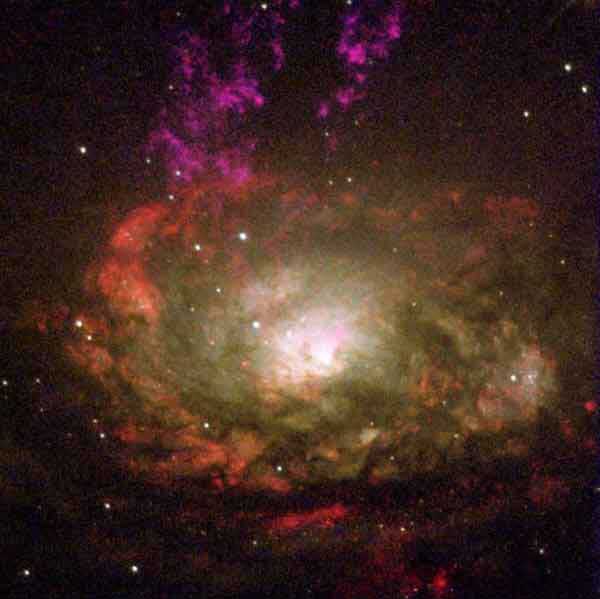The Circinus Galaxy, a Seyfert 2 galaxy. Credit: A. S. Wilson, P. L. Shopbell, C. Simpson, T. Storchi-Bergmann, F. K. B. Barbosa, M. J. Ward, WFPC2, HST, NASA. Seyfert galaxies are a class of galaxies with nuclei that produce spectral line emission from highly ionized gas[1], named after Carl Keenan Seyfert, the astronomer who first identified the class in 1943[2]. They are a subclass of active galactic nuclei (AGN), and are thought to contain supermassive black holes[1].
Seyfert galaxies are characterized by extremely bright nuclei, and spectra which have very bright emission lines of hydrogen, helium, nitrogen, and oxygen. These emission lines exhibit strong Doppler broadening, which implies velocities from 500 to 4000 km/s, and are believed to originate near an accretion disk surrounding the central black hole[3]. These emission lines may come from the surface of the accretion disk itself, or may come from clouds of gas illuminated by the central engine in an ionization cone. The exact geometry of the emitting region is difficult to determine due to poor resolution. However, each part of the accretion disk has a different velocity relative to our line of sight, and the faster the gas is rotating around the black hole, the broader the line will be. Similarly, an illuminated disc wind also has a position-dependent velocity. The narrow lines are believed to originate from the outer part of the AGN where velocities are lower, while the broad lines originate closer to the black hole. This is confirmed by the fact that the narrow lines do not vary detectably, which implies that the emitting region is large, contrary to the broad lines which can vary on relatively short timescales. Reverberation mapping is a technique which uses this variability to try to determine the location and morphology of the emitting region. Seyfert galaxies also show strong emission in the radio, infrared, ultraviolet, and X-ray parts of the spectrum. The radio emission is believed to be synchrotron emission from the jet. The infrared emission is due to radiation in other bands being reprocessed by dust near the nucleus. The highest energy photons are believed to be created by inverse compton scattering by a high temperature corona near the black hole. Classification of Seyfert galaxies Seyferts were first classified as Type 1 or 2, depending upon whether the spectra show both narrow and broad emission lines (Type 1), or only narrow lines (Type 2). They are now given a fractional classification depending upon the relative strengths of the narrow and broad components (e.g. Type 1.5 or Type 1.9)[3]. The narrow and broad components are believed to both originate from the accretion disk, but in Type 2 Seyferts it is believed that the broad component is obscured by dust and/or by our viewing angle on the galaxy. In some Type 2 Seyfert galaxies, the broad component can be observed in polarized light; it is believed that light from the broad-line region is scattered by a hot, gaseous halo surrounding the nucleus, allowing us to view it indirectly. This effect was first discovered by Antonucci and Miller in the Type 2 Seyfert NGC 1068. See also * Low-ionization nuclear emission-line region, another class of galaxies that contain AGN References 1. ^ a b L. S. Sparke, J. S. Gallagher III (2007). Galaxies in the Universe: An Introduction. Cambridge: Cambridge University Press. ISBN 0-521-67186-6. 2. ^ C. K. Seyfert (1943). "Nuclear Emission in Spiral Nebulae". Astrophysical Journal 97: 28-40. 3. ^ a b Donald E. Osterbrock, Gary J. Ferland (2006). Astrophysics of Gaseous Nebulae and Active Galactic Nuclei. Sausalito, CA: University Science Books. ISBN 1-891389-34-3. Links Retrieved from "http://en.wikipedia.org/"
|
|


